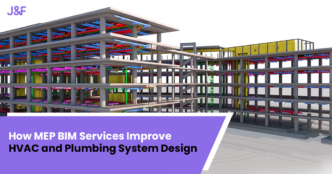The construction industry is experiencing a transforming shift thanks to rapidly evolving technologies and increased demands for sustainable, cost-effective, and long-lasting buildings. Structural engineering is an indispensable part of the construction sector, serving as a backbone for projects regardless of size and complexity. Accuracy and precision sit at the forefront of structural engineering, allowing for quality and robust construction. BIM, i.e., Building Information Modeling, has rephased the way structural engineering is carried out, making it more impactful and efficient than ever. BIM has eased how structural engineers design, collaborate, and build.
What is BIM?
Construction projects can be taxing to handle, especially when there is a lack of communication among stakeholders. BIM fills this fundamental gap by integrating people, data, and workflows across the project lifecycle. Being a robust software, BIM can visualize the entire project and its variables on a screen, facilitating key information to stakeholders, including structural engineer consultants, as and when required. This reinforces accuracy and obliterates ambiguity, ensuring hassle-free project execution from start to finish. It amplifies the collaboration and keeps a constant tab on progress no matter the project’s phase.
The Significance of BIM in Structural Engineering
By enhancing efficiency, accuracy, and collaboration, BIM has emerged as a transformative solution in structural engineering. Here is the breakdown of some prominent benefits that it offers:
1. Error Reduction and Rework Minimization
Traditional construction methods rarely stay aligned with predetermined timelines, resulting in conflict and budget spikes. BIM addresses these gaps by facilitating a single-window model that eases project management, providing ground for expedited and accurate decision-making. BIM enables structural engineers to pinpoint design pitfalls in the pre-construction phase, ensuring considerable time-saving and reduced rework.
2. Enhanced Team Collaboration
BIM brings all the stakeholders and project variables under one ambit, spanning every phase of project development as comprehensively as possible. It renders real-time information on several factors, including design, clashes, delay, material supply chain, manpower, etc., providing stakeholders with much-needed transparency for seamless project execution.
3. Optimized Design Quality
BIM can create a range of optimized design scenarios based on land size and architectural requirements, giving more flexibility to stakeholders so that they can make the most out of the project. These design scenarios are not only functional but also remarkably robust.
4. Time Savings Through Automation
BIM automates tedious reworks like shop drawings and structural analyses, which can be utterly time-consuming. This enables stakeholders, including engineers, to shift their focus to innovation and design potential, unlocking new possibilities while the project is in progress.
How BIM Benefits Structural Engineering Projects
BIM in structural engineering is not just about streamlining the entire process and enhancing collaboration; it is also about boosting project performance from start to finish. From cost estimation to design, BIM can make a considerable contribution to seamless project execution.
- Accurate Cost Estimates: BIM provides comprehensive insights into the supply chain, material procurement, and cost, easing the blow for budgeting.
- Reduced Project Delays: Swift detection of potential bottlenecks before key endeavors, reducing disruptions during construction.
- Improved Construction Quality: All-encompassing designs and simulations pave the foundation for robust and safer structures.
- Enhanced Client Satisfaction: In-depth visualization adds to the decision-making, allowing stakeholders to ensure the timely execution of the project. This can lead to improved client satisfaction.
Unlock precision, efficiency, innovation, and seamless collaboration with J&F’s BIM solutions tailored for structural engineer consultants. It is time to elevate productivity and quality.
Applications of BIM in Structural Engineering
BIM is a boon for structural engineer consultants thanks to the possibilities it offers from the management and design front. Here are some of its key applications:
1. 3D Modeling
BIM is phenomenal on the design front as it can offer detailed 3D models of different structural components with utmost clarity and accuracy. From foundations and beams to columns, BIM can turn all types of components into a visual model, ensuring a clear understanding of the building’s framework.
2. Structural Analysis
BIM enables stakeholders to perform comprehensive analysis to ensure whether or not a building is robust or capable of withstanding natural calamities.
3. Detailed Drawings
BIM generates accurate and comprehensive engineering drawings, reducing flaws and ensuring stakeholders stay in loop.
4. Cross-Disciplinary Coordination
BIM boosts coordination among stakeholders such as structural engineers, architects, and MEP (Mechanical, Electrical, and Plumbing) teams, keeping all aspects of the design streamlined and aligned.
5. Construction Simulations
By simulating construction sequences, BIM can take a closer look at the potential barriers or bottlenecks that can lead to delays or other issues. This can help save considerable time and resources.
6. Project Information Management
BIM syncs key processes and considers all the variables, including schedules, costs, and material data, easing project management and ensuring improved decision-making.
Also Read: Role of Advanced Robotics in Structural Steel Fabrication
The Future of Structural Engineering with BIM
The integration of BIM into structural engineering shall unlock new possibilities in building design and strength. Through improved accuracy and teamwork, BIM will transform the way the projects are handled and supervised, paving the foundation for more sustainable and longer-lasting structures.
Structural engineers who embrace BIM can put aside fundamental pitfalls that otherwise are hard to handle. With BIM capabilities, stakeholders can explore uncharted territory of innovation.
Why Structural Engineer Consultants Should Adopt BIM
For structural engineer consultants, the BIM has become an absolute necessity. From identifying project pitfalls and fixing coordination issues to stimulating a real-world view, BIM can handle a number of tasks at once with utmost accuracy and precision. This can pave the foundation for effortless project execution from start to finish. By integrating BIM into their practice, consultants can:
- Enhance their service offerings and attract more clients.
- Reduce project risks and improve client trust.
- Deliver higher-quality designs that stand the test of time.
Conclusion
In the ever-evolving construction industry, structural engineering sits at the center stage of innovation. BIM has emerged as a breakthrough solution that overcomes several problems that have been hindering project execution for ages. BIM stands out with its ultimate precision, accuracy, and ability to sync cross-functional teams regardless of the project’s complexity or scalability.







